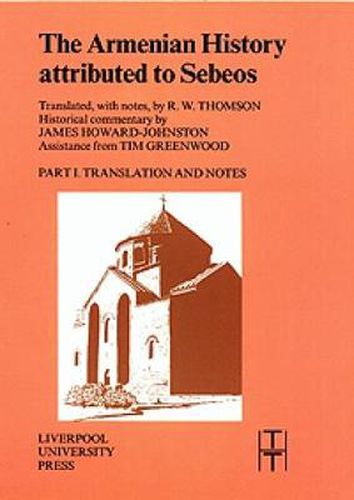Readings Newsletter
Become a Readings Member to make your shopping experience even easier.
Sign in or sign up for free!
You’re not far away from qualifying for FREE standard shipping within Australia
You’ve qualified for FREE standard shipping within Australia
The cart is loading…






The history attributed to Sebeos is one of the major works of early Armenian historiography. Although anonymous, it was written in the middle of the 7th century, from which period comparable chronicles in Greek and Syriac are sparse. Sebeos traces the fortunes of Armenia in the 6th and 7th centuries within the broader framework of the Byzantine-Sasanian conflict. His main theme covers the reign of Khosrov II (589-628) and the early Muslim expansion, emphasizing Armenian participation in the international scene. This is an English translation of the 1979 critical edition of the classical Armenian text. Notes to the translation elucidate persons and dates, and explain difficulties in the original Armenian. The detailed historical commentary compares Sebeos’s account with other available sources and highlights the particular value of this Armenian witness to the momentous events of his time. The book is intended for those involved in the study of Armenia, the Caucasus, the Eastern Roman Empire and the Middle East in late antiquity. It is also of relevance to Islamists, since Sebeos not only sets the scene for the coming of Islam but provides the only substantial non-Muslim account of the initial period of expansion. The notes are specifically aimed at the reader unfamiliar with Armenian; with the maps they help the non-specialist to negotiate the complexities of Armenian society and the intricacies of family politics. The historical commentary incorporates an assessment of the accuracy and value of Sebeos’s text.
$9.00 standard shipping within Australia
FREE standard shipping within Australia for orders over $100.00
Express & International shipping calculated at checkout
The history attributed to Sebeos is one of the major works of early Armenian historiography. Although anonymous, it was written in the middle of the 7th century, from which period comparable chronicles in Greek and Syriac are sparse. Sebeos traces the fortunes of Armenia in the 6th and 7th centuries within the broader framework of the Byzantine-Sasanian conflict. His main theme covers the reign of Khosrov II (589-628) and the early Muslim expansion, emphasizing Armenian participation in the international scene. This is an English translation of the 1979 critical edition of the classical Armenian text. Notes to the translation elucidate persons and dates, and explain difficulties in the original Armenian. The detailed historical commentary compares Sebeos’s account with other available sources and highlights the particular value of this Armenian witness to the momentous events of his time. The book is intended for those involved in the study of Armenia, the Caucasus, the Eastern Roman Empire and the Middle East in late antiquity. It is also of relevance to Islamists, since Sebeos not only sets the scene for the coming of Islam but provides the only substantial non-Muslim account of the initial period of expansion. The notes are specifically aimed at the reader unfamiliar with Armenian; with the maps they help the non-specialist to negotiate the complexities of Armenian society and the intricacies of family politics. The historical commentary incorporates an assessment of the accuracy and value of Sebeos’s text.